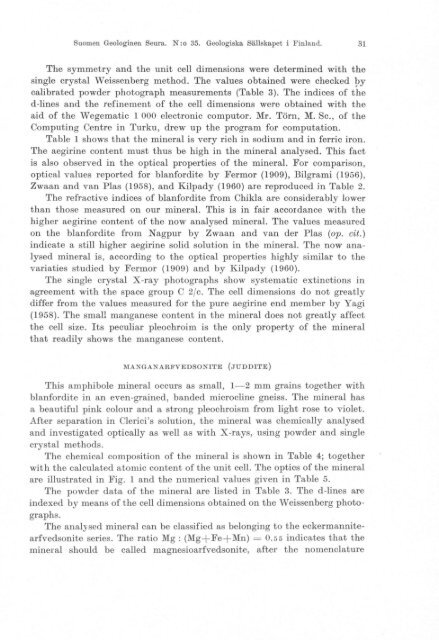COMMISSION GEOLOGIOUE - Arkisto.gsf.fi
COMMISSION GEOLOGIOUE - Arkisto.gsf.fi
COMMISSION GEOLOGIOUE - Arkisto.gsf.fi
You also want an ePaper? Increase the reach of your titles
YUMPU automatically turns print PDFs into web optimized ePapers that Google loves.
Suomen Geologinen Seura. N:o 35. Geologiska Sällskapet i Finland. 31<br />
The symmetry and the unit cell dimensions were determined with the<br />
single crystal Weissenberg method. The values obtained were checked ~y<br />
calibrated powder photograph measurements (Table 3). The indices of the<br />
d-lines and the re<strong>fi</strong>nement of the cell dimensions were obtained with the<br />
aid of the Wegematic 1 000 electronic computor. MI'. Törn, M. Sc., of the<br />
Computing Centre in Turku, drew up the program for computation.<br />
Table 1 shows that the mineral is very rich in sodium and in ferric iron.<br />
The aegirine content must thus be high in the mineral analysed. This fact<br />
is also observed in the optical properties of the mineral. For comparison,<br />
optical values reported for blanfordite by Fermor (1909), Bilgrami (1956),<br />
Zwaan and van Plas (1958), and Kilpady (1960) are reproduced in Table 2.<br />
The refractive indices of blanfordite from Chikla are considerably lower<br />
than those measured on our mineral. This is in fair accordance with the<br />
higher aegirine content of the now analysed mineral. The values measured<br />
on the blanfordite from Nagpur by Zwaan and van der Plas (ap. cit.)<br />
indicate a still higher aegirine solid solution in the mineral. The now analysed<br />
mineral is, according to the optical properties highly similar to the<br />
variaties studied by Fermor (1909) and by Kilpady (1960).<br />
The single crystal X-ray photographs show systematic extinctions in<br />
agreement with the space group C 2/c. The cell dimensions do not greatly<br />
differ from the values measured for the pure aegirine end member by Yagi<br />
(1958). The smaIl manganese content in the mineral does not greatly affect<br />
the cell size. Its peculiar pleochroim is the only property of the mineral<br />
that readily shows the manganese content.<br />
MANGANARFVEDSONITE (JUDDITE)<br />
This amphibole mineral occurs as small, 1- 2 mm grains together with<br />
blanfordite in an even-grained, banded microcline gneiss. The mineral has<br />
a beautiful pink colour and a strong pleochroism from light rose to violet.<br />
After separation in Clerici's solution, the mineral was chemically analysed<br />
and investigated optically as weH as with X-rays, using powder and single<br />
crystal methods.<br />
The chemical composition of the mineral is shown in Table 4; together<br />
with the calculated atomic content of the unit cello The optics of the mineral<br />
are illustrated in Fig. 1 and the numerical values given in Table 5.<br />
The powder data of the mineral are listed in Table 3. The d-lines are<br />
indexed by means of the cell dimensions obtained on the Weissenberg photographs.<br />
The analysed mineral can be classi<strong>fi</strong>ed as belonging to the eckermannitearfvedsonite<br />
series. The ratio Mg: (Mg+Fe+Mn) = 0. 55 indicates that the<br />
mineral should be called magnesioarfvedsonite, after the nomenclature
















